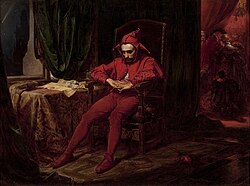Stańczyk (court jester)
Stańczyk (* around 1480, † around 1560) was a court jester at the court of the Polish kings Alexander (1501–1506), Sigismund I the Elder (1506–1548) and Sigismund II August (1548–1572).
There is little credible information about his résumé. He came from a farming family from Proszowice near Cracow . He owed his privileged position at court to his astuteness, and thanks to his freedom from fools he relentlessly criticized the unconcerned politics of the rulers.
Polish Renaissance writers Łukasz Górnicki , Jan Kochanowski , Martin Cromer , Mikołaj Rej and others. a. often quoted his blunt statements (or ascribing their own thoughts to him).
In the 1860s , the political group named after him, the Stańczycy , emerged in the western part of Galicia , striving for more freedom for the Polish population in the Austrian part of Poland.
In the Polish literature of the late 19th century he was often portrayed as the one who worried about the future of the kingdom at the court of the Polish kings.
In the famous painting Stańczyk during the ball at the court of Queen Bona, when the news of the loss of Smolensk arrives by Jan Matejko , Stańczyk is depicted mourning the loss of Smolensk during the cheerful court ball .
In Stanisław Wyspiański's play “The Wedding” (1901), Stańczyk appears with his fool's staff among the invited guests to denounce the inactivity of the population of divided Poland at the time.
Since 1980 he has given its name to Stańczyk Hill , a hill on King George Island in the archipelago of the South Shetland Islands in Antarctica .
literature
- Wielka Encyklopedia Powszechna PWN, t. X, str. 794, PWN, Warszawa, 1968.
Web links
| personal data | |
|---|---|
| SURNAME | Stańczyk |
| ALTERNATIVE NAMES | Gąska |
| BRIEF DESCRIPTION | Court jester of Polish kings |
| DATE OF BIRTH | around 1480 |
| DATE OF DEATH | around 1560 |
